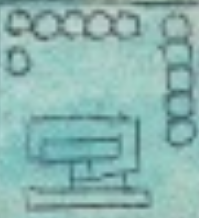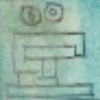Matlactli Once Calli (Mdz2r)
This simplex glyph and notation represents a date, the solar year (xihuitl) Eleven House (Matlactli Once Calli). It includes a notation with eleven ones (small circles without dots or smaller concentric circles) and a glyph for a house or building (calli) shown in profile, facing to the viewer's left. The ones are grouped in a way that would echo the counting of fingers and toes, and results in a mathematical equation, 5 + 5 + 1 + 11. The house is rectangular with right angles, and it is shown in profile, facing toward the viewer's left. The notation of eleven ones consists of three groupings. Running up the right side toward the corner is a group of five. Across the top and hitting up against the upper left corner is another group of five. And a single one appears on the left boundary of the box, nearing the top. The entire glyph is contained within a black-line drawing of a box (barely visible in this image), which is an indication that this is a year date, and all the contents are covered with a turquoise blue paint. The word xihuitl stands for both turquoise and year, which are homophones, and therefore the paint could be interpreted to be a phonetic indicator for "year."
Stephanie Wood
The notation is like a mathematical equation of 5 + 5 + 1 = 11 (if read from right to left). The groupings of two fives remind us of how people once counted on their fingers, and perhaps the eleventh circle would have represented a toe. Counting on fingers and toes resulted in the formation of a base 20, or vigesimal, system. The placement of ones can vary, and the circles can contain dots or smaller concentric circles, as becomes apparent in examples below. The "once" in the Nahuatl means "plus one." It does not mean eleven, so it is just a coincidental similarity with the Spanish word for eleven "once." The equation of five plus five plus one involves the inclusion of visual spacing that echoes the "plus" of the equation. We are calling these visual ligatures. In the alphabetic writing of eleven, however, the equation is ten (matlactli) plus (on) one (ce), with just one ligature spelled out. Ten, of course, equals two fives, but the oral and alphabetic naming of numbers does not retain full, more broken out equation that we see visually.
Stephanie Wood
c. 1541, or by 1553 at the latest
calendars, calendarios, dates, fechas, casas, edificios, números, mahtlactli, xiuhpohualli, año, turquesa, xihuitl, nombres de años

matlactli, ten, https://nahuatl.wired-humanities.org/content/matlactli
matlactli once, eleven, https://nahuatl.wired-humanities.org/content/matlactli-once
ce, one, https://nahuatl.wired-humanities.org/content/ce
calli, house, building, https://nahuatl.wired-humanities.org/content/calli
Once Casa
Stephanie Wood
Codex Mendoza, folio 02 recto, https://digital.bodleian.ox.ac.uk/objects/2fea788e-2aa2-4f08-b6d9-648c00..., image 14 of 188.
The Bodleian Libraries, University of Oxford, hold the original manuscript, the MS. Arch. Selden. A. 1. This image is published here under the UK Creative Commons, “Attribution-NonCommercial-ShareAlike 3.0 License” (CC-BY-NC-SA 3.0).



